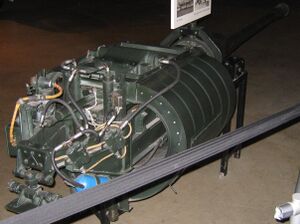Engineering:BK 5 cannon
| BK-5 cannon | |
|---|---|
 Rear view of a BK 5 in the National Museum of the United States Air Force, Dayton, Ohio, showing the semi-circular magazine | |
| Type | Autocannon |
| Place of origin | Germany |
| Service history | |
| In service | 1944–1945 |
| Wars | World War II |
| Production history | |
| Designer | Rheinmetall |
| Designed | 1943 |
| Manufacturer | Rheinmetall |
| Produced | 1943–1945 |
| No. built | approx. 300 |
| Specifications | |
| Mass | 540 kilograms (1,190 lb) |
| Cartridge | 50 mm |
| Rate of fire | 45 rounds per minute. |
The Bordkanone 5, or BK 5 for short, was a 50 mm autocannon intended primarily for use against Allied heavy bombers, especially the United States Army Air Forces 's (USAAF) Boeing B-17. The heavy, large calibre shells had a high muzzle velocity, and therefore great momentum, allowing them to be accurately fired from long ranges, well outside the range of the defensive guns mounted on the bombers, and the large explosive content of each shell almost ensured destruction of any bomber that was hit by even one.
Rheinmetall was given a contract in 1943 to adapt the 50 mm KwK 39 tank gun, from the Panzer III tank, for aerial use in the twin-engined Me 410 Hornisse bomber destroyer. They were installed as Umrüst-Bausätze (Factory Modification) 4 in the Me 410 A-1/U4, and experimentally, in two Me 262 A-1a/U4 jet fighter prototypes (though these were not used operationally),[1] as the MK 214 cannon of similar caliber was not yet available. An experimental fitment of the BK 5 in an undernose Bola (or "dustbin") mount on a small number of He 177A-3 heavy bombers was part of a small force of the bombers that was given the task of suppressing Flak on the Eastern Front near Stalingrad early in the winter of 1942-43 as the A-3/Rüstsatz 5 version, allegedly nicknamed the Stalingradtyp. The semi-circular magazine of the BK 5 weapon system held 21 rounds.
Approximately 300 were produced and it saw only limited action, most notably in the Me 410 A-1/U4 aircraft that served with the II. Gruppe of Zerstörergeschwader 26 (ZG 26). It was also mounted on the Junkers Ju 88 P-4 night attack[citation needed] aircraft. Intended for long-range shots, the cannon was given a telescopic sight in addition to the Me 410's standard Revi C12C gunsight, in order to make it easier to take long-range shots from outside a bomber's defensive perimeter, as a "stand-off" weapon system. This proved to be more of a hindrance than a help in the turning fights in which the Me 410s often found themselves when engaged by enemy fighters, as the maneuvering targets easily escaped from the telescopic sight's small field of view, forcing them to use to normal sights instead. Since the BK 5 was almost useless against such small, nimble targets, the use of the telescopic sight was unnecessary in these situations anyway.[2]
As installed in the Me 262, with the muzzle protruding well beyond the nose of the fighter, the cannon was found to be prone to jamming, and if fired at night the BK 5's muzzle flash tended to temporarily blind the pilot's night vision.[1]
According to the account of the engagements against the USAAF by II./ZG 26 from late February through mid-April 1944 mentioned at a German language website,[3] the 53 Me 410 Hornisse of that Zerstörergruppe equipped with the BK 5 - as the Umrüst-Bausätze factory modification designated /U4 for the Me 410 series of aircraft - were said to have shot down a total of 129 B-17 Flying Fortress and four B-24 Liberator heavy bomber aircraft, distributed over a series of five or six interceptions, all while losing only nine of their own Me 410s.[4][dubious ]
See also
- Other German Bordkanone heavy-calibre ordnance:
- BK 3,7
- BK 7,5
- MK 112 cannon
- Vickers "S" gun
- QF 6pdr Class M Mark I with Auto Loader Mk III (6pdr Molins gun)
- Nudelman-Suranov NS-45
Notes
References
- Stocker, Werner; Petrick, Peter (2007), Messerschmitt Me 210 / Me 410 Hornisse/ Hornet, Midland Publishing, ISBN 1-85780-271-3.

